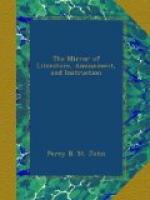It has been often observed, that birds, in the course of their flight from one country to another, will frequently resort to the rigging of a ship, as a resting-place in their transit across the wide ocean. Mr. Gray, in his “Letters on Canada,” gives the following instance:—Among the extraordinary things, he observes, one meets with at sea, it is not one of the least surprising to observe small land birds several hundred miles from land. I was sitting on deck, when, to my great surprise, my attention was arrested by the warbling of a bird. I looked up, and saw a linnet perched on the rigging, and whistling with as much ardour as if on a bush in a green meadow. It is not a little astonishing how these little birds should be able to continue on the wing so long as is necessary to fly several hundreds of miles, particularly when the usual shortness of their flight is considered. They continue sometimes with a vessel several days, and are frequently caught by the sailors; but it is remarked that they seldom live, though every care is taken to give them proper food. When the vessel rolls much, they find it difficult to retain their footing on the rigging, and you see them forced, as it were, to resume their flight in search of a better resting-place.
THE ADVANTAGES OF AFFLICTION.
Behold this vine,
I found it a wild tree, whose wanton strength
Had swollen into irregular twigs
And bold excrescences,
And spent itself in leaves and little
rings;
So in the flourish of its outwardness
Wasting the sap and strength
That should have given forth fruit;
But when I pruned the tree,
Then it grew temperate in its vain expanse
Of useless leaves, and knotted, as thou
seest,
Into these full, clear clusters, to repay
The hand that wisely wounded it.
Repine not, O my son!
In wisdom and in mercy heaven indicts,
Like a wise leech, its painful remedies.
SOUTHEY.
WEATHERCOCKS.
Weathercocks do not always show the real direction of a very gentle wind. The strange figures of them, usually the productions of capricious fancy, is one cause of their imperfection as vanes to indicate the wind. Griffins, half-moons, foxes, or figures of St. Margaret and the dragon, are not good shapes for weathercocks, which ought to be plain fans, the large surface of one side being counterbalanced against the weight of the other.




